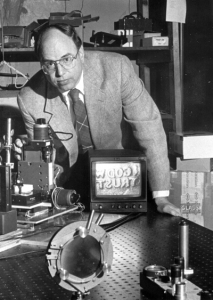Prof. Dave Staelin: 54 Years at MIT and Counting
-
-
slice.mit.edu
- 1
Filed Under
Recommended

"When I arrived in 1956 my tuition was $1100, there were one or two coeds per section, we had mandatory ROTC, surplus battleship gray paint graced the halls, porters cleaned dormitory rooms daily and changed the linens, and Cambridge chocolate, soap, and other factories helped signal the wind direction," says Dave Staelin ’60, SM ’61, ScD ’65 in a recent EECS newsletter interview.
Staelin's MIT experiences have been vast. He has been a member of the EECS faculty and Research Laboratory on Electronics 1965, he co-founded the MIT Venture Mentoring Service, and has served on a host of NASA committees and working groups, including the Space Applications Advisory Committee; the Advanced Microwave Sounder Working Group; the Geostationary Platform-Earth Science Steering Committee; and the Tropical Rainfall Measuring Mission Science Steering Group.
Read the article, below, to learn how his career evolved from radioastronomy to working at Lincoln Labs to starting three companies and now working on theories of neuronal computation.
An Interview with Professor Dave Staelin
Originally published by the MIT Department of Electrical Engineering and Computer Science
You are one of the few active faculty members who have been at MIT for more than half a century—what are the main changes you have seen?
When I arrived in 1956 my tuition was $1100, there were one or two coeds per section, we had mandatory ROTC, surplus battleship gray paint graced the halls, porters cleaned dormitory rooms daily and changed the linens, and Cambridge chocolate, soap, and other factories helped signal the wind direction. We used slide rules and tables, and some “computer rooms” were still staffed by people using only mechanical calculators. Most subjects were taught either in large lectures or as recitations without teaching assistants within more restricted curricula. Enthusiasm for technology was rampant and a wide array of industrial, academic, and professional opportunities awaited as the space, nuclear, electronic, and computer ages were just beginning.
How did you happen to pursue remote sensing and estimation, and what were some of the highlights?
I originally anticipated an industrial research career, but was referred by the RLE director, Henry Zimmermann, to the new radioastronomy group under Alan Barrett (former PhD student of Charles Townes, laser Nobelist and MIT provost). They needed advanced signal processing, which was my primary interest along with electromagnetics.
A shortage of EE PhD radioastronomers led to my initial faculty appointment; tenure was facilitated by my PI roles in the first two microwave spectrometers that orbited the Earth monitoring the weather, and development of an NlogN algorithm that enabled our discovery of the Crab Nebula pulsar, which helped prove pure nuclear matter existed as neutron stars. Our microwave satellite remote sensing work continues since such sensors are now the single most effective data source enabling week-long global weather forecasts and observation of certain critical climate parameters.
How did your research become so diverse, extending now even to theories of neuronal computation?
My senior project for Jerry Weisner (later J.F. Kennedy’s science advisor and MIT president) partly involved neural computation, as did my SM thesis, so there was precedent for that. More important was NASA’s reluctance to develop novel passive microwave meteorological sensors after 1975, which forced me to continually re-invent my research agenda.
So I became a co-investigator on Voyager 1 and 2 and studied non-thermal radio emission from the outer planets, helped develop optical astrometric interferometry to find extra-solar planets with Mike Shao and others, optimized heterogeneous communications network architectures, developed video compression technology, applied estimation theory to data-rich manufacturing problems under the MIT Leaders for Manufacturing program, and served as an Assistant Director of Lincoln Laboratory for 11 years. The practical aspects of these initiatives could often be “published” only by demonstration, so I helped start three companies over the years: Environmental Research and Technology (ERT, now part of AECOM), PictureTel (now part of Polycom), and EMPower (manufactured electric scooters; purchased by ZAP)
You apparently have collaborated with many others along the way. Can you describe some of these collaborations?
One benefit of being an MIT faculty member is the opportunity to collaborate with some of the world’s finest students and technologists. Remote sensing students establishing lifelong careers include (among others) Joe Waters, Phil Rosenkranz, Paul Steffas, Ed Kim, Al Gasiewski, Bill Blackwell, Vince Leslie, and “Pop” Surussavadee, all of whom have remained collaborative.
Also exceptional was the opportunity to collaborate on video signal processing with faculty like Jae Lim and Bill Schrieber and with students like Henrique Malvar (Microsoft), Brian Hinman (a founder of PictureTel, Polycom, and 2Wire), Greg Wornell (now EECS faculty), Jim Preisig, Gregg Papadopoulos (once EECS faculty), Jerry Shapiro, Jeff Bernstein, and others. Other students (UROP, etc.) later became MIT faculty, such as Steve Ward, Jeff Lang, Muriel Medard, Tomas Arias, and Hoo-Min Toong.
Collaborators in venture formation included Norman Gaut, Mike Dertouzos, Brian Hinman, Marty Schlecht, Don Steinbrecher, Peter Szolovitz, and others. These contributed to my formation, with Alec Dingee, of the MIT Venture Mentoring Service in 2000 and later with Sherwin Greenblatt, which in turn has spawned more collaborations. Jin Au Kong, Erich Ippen, I, and many others also collaborated over decades to bring our undergraduate electromagnetic curriculum into the new millennium.
I can’t imagine a better environment for technically inclined students, staff, or faculty than MIT. I am enormously grateful to have had that opportunity.








Comments
Alan Cassel
Tue, 06/22/2010 9:31pm
You should also add that, during his time as a student at M.I.T., he provided service to the community and the Institute via the Alpha Chi chapter of the Alpha Phi Omega service fraternity. As an Institute professor afterwards, he has also served as an occasional advisor to the chapter.